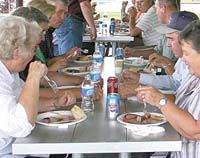| The CIB board members seem to enjoy their barbeque at the Emery County Fairgrounds in Castle Dale. |
Emery County took the opportunity to show off just a little as the Permanent Community Impact Fund Board met in Castle Dale. They stayed at the Castle Valley Ranch and toured the power plant while they were here. The board attended the Desertview ProRodeo along with their meetings. They also visited the Millsite Golf Course. The wives of board members were also taken on a field trip of the new North Springs shooting facility and visited the Wedge.
Keith Burnett began the CIB meeting with a briefing of the board on the agenda items for this trimester funding meeting. He went over and explained each agenda item, the agency requesting the funding, and the reasons for the request. He reviewed the details and informed the board of any follow up that had taken place concerning the request.
Gordon Walker began the formal meeting by stating his appreciation to Emery County and its Commissioner Drew Sitterud for their hospitality in hosting this meeting. Commissioner Drew Sitterud welcomed the entire group to Emery County.
This board was established to control the flow of mineral royalty monies to the counties or state entities which are socially or economically impacted by the extraction of minerals from public lands. The State of Utah allocates 32 percent of the mineral lease money paid to the state by companies to the PCIB for distribution to impacted areas. This 11 member board takes and reviews applications, then disburses the monies.
Each rural community in Utah where mineral extraction has an impact, can boast of improvements made in their area from this mineral royalty money. All cities in Emery County have received loans or grants to make much needed upgrades to sewer or water systems, fire fighting capabilities, or recreational facilities which benefit the entire community.
| Emery County Commissioner Drew Sitterud, center, visits with CIB members Brad Hancock and Ralph Okerlund. |
Some of the requests considered at the July 26 meeting were: sewer system improvement in the Ashley Valley Water and Sewer Improvement District; search and rescue building from the Carbon County Building Authority; aquatics center in Moab; town hall and fire station for Myton, Elsinore and Lyman; and culvert improvements in Monroe.
Applications are made by state or county agencies for consideration in one of the trimesters during the year long funding period. The deadlines for submitting applications for each of the trimester funding cycles will be no later than the following dates: first trimester, Dec. 1; second trimester, April 1; third trimester, Aug. 1.
The CIB holds meetings on the first Thursday of every month during the trimester to consider and review the applications. The final meeting of the trimester is the funding meeting. This meeting is when the applicants learn about the success or failure of their application.
An interest bearing loan is the preferred method of issuing money from the CIB. In many instances, they will give grants or no-interest loans. In other cases, a combination of loan or grant may be decided upon.
During the next several hours, the board considered each agenda item. Many of the first few items had been on previous funding meeting agendas and had been tabled for reconsidered with some alterations. These items were quickly approved.
Other agenda items were opened for discussion and representatives of the entity making the application were questioned by members of the board. In several instances, no one was present to represent the applicant and the item was not discussed any further. It was immediately tabled until the next funding trimester in hopes that someone would be present to answer questions.
| Members of the Permanent Community Impact Fund Board meet at the Museum of the San Rafael for the funding cycle meeting. |
A sample of the questions asked were: the ability of the applicant to repay the loan; the ability of the applicant to maintain the project upon completion; and the feasibility of downsizing the project. The board then considers the effectiveness of the project and makes a decision.
Another portion of the agenda dealt with projects that have been approved and the agency or entity has returned with a request to make a change from the original application. Many applicants return to request additional funding due to the inflation rates of building materials and labor costs.
In one instance considered at the meeting, an agency was requesting funding for a project as a 100 percent grant. The board discussed and informed the representative that if this project was completed, the city would save several thousand dollars a year. This would allow the city to make payments to the CIB on a 0 percent interest loan in the amount of the request. The board granted the request for a 100 percent loan at 0 percent interest.
Many of the applicants who came to this meeting were appearing before the board for the second time. In one instance, the board had made recommendations to the applicant, and they were back with the answers to the suggestions in hand. These answers and alterations enabled the applicant to be successful on his second trip.
With another funding meeting behind them, the CIB will continue to meet each month to review and discuss the best ways to benefit the areas of the State of Utah which are impacted by the extraction of minerals.

